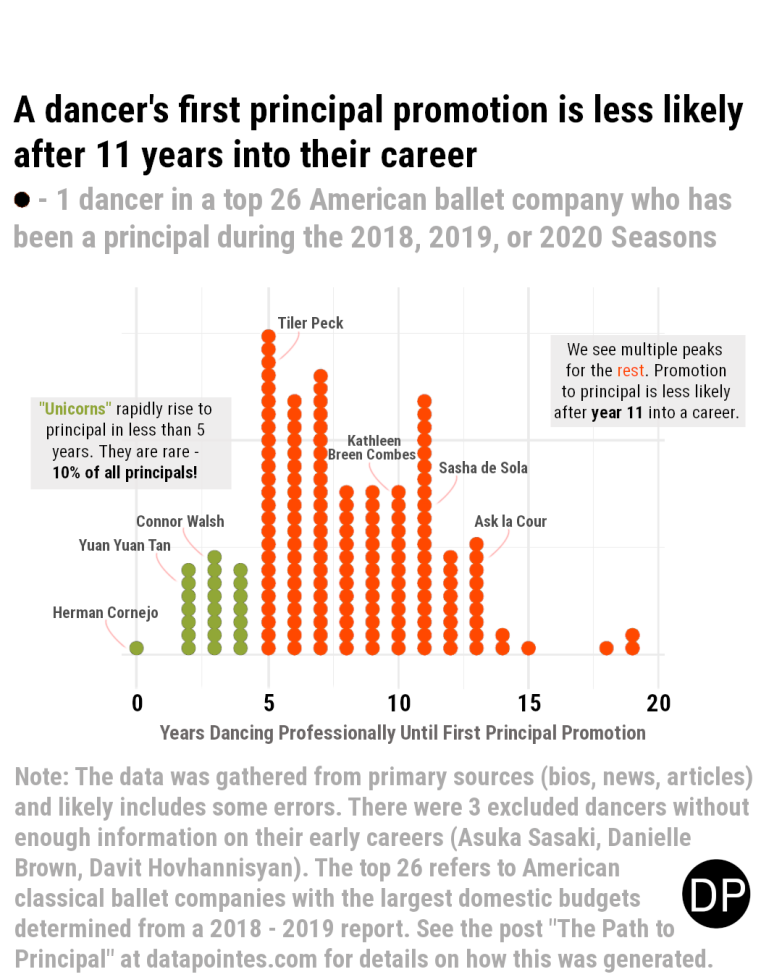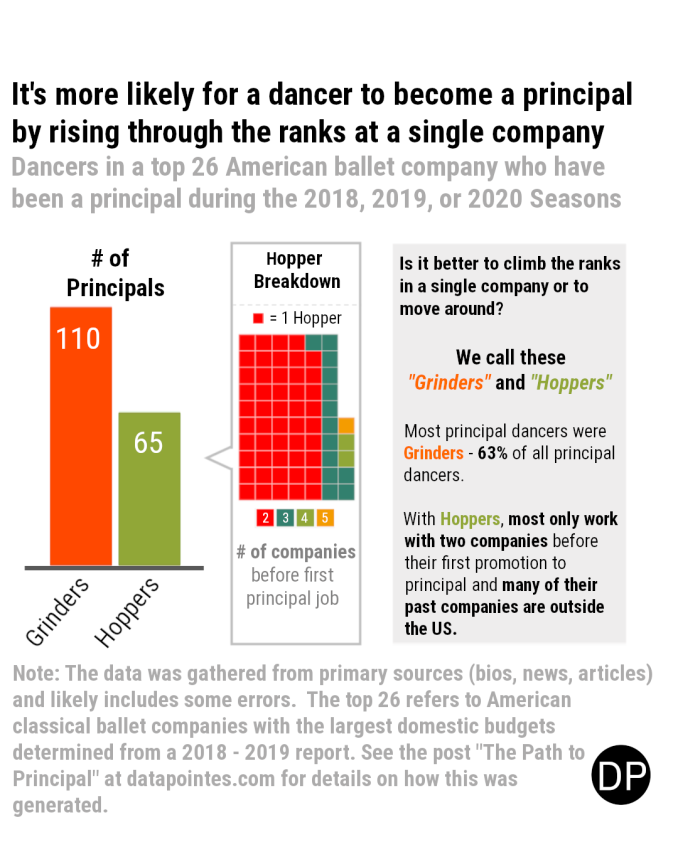Season | Promotions |
|---|---|
2019 | 39 |
2020 | 74 |
2021 | 65 |
2022 | 125 |
Number of dancers promoted in recorded companies since the preceding season. The 2019 season only includes the top seven US companies. Does not include second company programs, NYCB apprentices, or special ranks (like guest principal). | |
10 Promotions
10.1 How many dancers are promoted each season?
See the key for company codes.
10.1.0.1 Number of Dancers Promoted In All Companies Recorded Broken Down By Season, Company, Rank, Group, & Gender
10.2 What are common features in American ballet dancers’ paths to principal dancer?
We currently only have this data up to the 2020-2021 Season for the top 26 companies by budget.
The principal dancers are the elite of the elite. Most professional dancers aspire to dance principal roles. But with only 154 out of 1024 dancers designated as principals in the largest 26 American ballet companies during the 2020-2021 Season, ranked principals make up only 15% of all dancers. How quickly do dancers rise to the top rank? At how many companies do they work before being promoted? When do they usually retire?
10.2.1 The Long and Winding Road
We reconstructed the paths of all principal dancers within our dataset (one season of just the top seven companies and two seasons of the top 26). Because we didn’t have a straightforward way of detecting leading dancers at unranked companies, we excluded them from this analysis. This left us with 175 unique principal dancers to analyze.
We then used primary sources (company/school/competition biographies, news sources, promotion updates) to confirm hires, promotions, retirements, and age (give or take a year) if available. We were able to find approximate age data for 139 of the dancers.
10.2.2 How quickly do dancers get promoted to principal?
Or, said another way, after how many years of dancing professionally does it become unlikely for a dancer to be promoted to principal?
For this estimate, we removed three dancers from our analysis because we lacked certain information about their early careers (Asuka Sasaki, Danielle Brown, Davit Hovhannisyan).

The average time to become a principal after first joining a company is 7.8 years (7.1 years for men and 8.5 years for women). The average age at promotion is 26.7 years.
Outliers exist, of course. There are prodigies who are promoted to principal at an extraordinarily young age. These dancers become principal dancers within four years of their first job. After 11 years of dancing, there is a substantial drop in the probability of becoming a principal dancer at one of the top 26 companies.
10.2.3 Time to Principal by Company
On average, how long does it take from joining as a new hire to becoming a principal dancer at each company?
Some companies require their dancers to spend years dancing in the proving grounds of the corps and soloist ranks. Others hire their principals directly from other companies.
10.2.4 At how many companies do dancers work before becoming principals?
Is it better to climb the ranks in a single company or to move around? We will call dancers with these differing approaches “grinders” and “hoppers!”
Only 37% of dancers (65 out of 175) hopped between companies at least once before becoming principals. This means most principals in the top 26 companies were grinders, remaining at the same company before their promotion.

Are principal dancers more likely to hop into the rank from within or from outside the top 26 companies? Hoppers danced at more companies outside of the top 26 before becoming principals than companies within the top 26 (71 versus 45 employments). Most of these companies were outside the US as well. We think this means that hopping is a strategy that foreign-born principals use more often than their US-born counterparts.
The hopping versus grinding debate also depends on which company we are examining. Some companies tend to hire “external principals” rather than prioritizing promoting their own dancers. Keep a lookout for this analysis in future versions of this report.